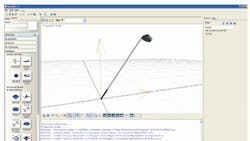Simulation drives golf club innovation
Distance and accuracy are two of the most important aspects of golf, especially when it comes to driving the ball over long stretches of land and water. Regardless of a player's skill level, sets of clubs and their design also shape the game. So when club manufacturer Cleveland Golf, Huntington Beach, Calif., wanted to increase the performance of its drivers, the company turned to MapleSim, a physical modeling and simulation tool from Maplesoft, Waterloo, Ontario, for assistance. In particular, Cleveland Golf's engineering team wanted to investigate the effects of different shaft designs on driver performance.
Shaft flexibility, including how bending and torsion varies down the shaft length, plays a critical role in determining how far golf balls travel. With the help of Dr. John McPhee, professor of systems design engineering at the University of Waterloo, they used MapleSim software to create a driver model. The shaft itself was modeled using the program's flexible beam component. The driver head model was then carefully designed to include the exact characteristics of the Cleveland Golf driver head, including detailed specifications, such as its mass and moments of inertia.
To simulate a variety of swings from different players, measurements were taken from players on the university's golf team. This information was entered into the model as a six-DOF motion of the grip, which in turn determined shaft movement. By modifying model parameters to match the properties of different club designs, it was possible to create several versions of the base model. When models were validated against experimental data, a high level of agreement was found between the simulation and experimental data for club head speed, as well as dynamic loft and droop at the instant of contact with the ball. MapleSim models also ran faster than similar models based on finite-element techniques.
By using validated dynamic models of a golf driver, Cleveland Golf now quickly explores different designs and “what if” scenarios to boost club performance, and minimize the need for expensive prototypes and costs associated with performing physical tests. For more information, visit maplesoft.com.
